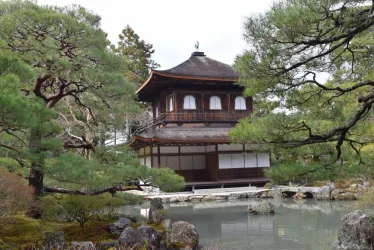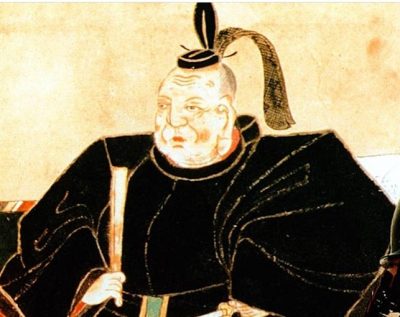The Warring States Period is called Sengokujidai (戦国時代) in Japan. There were a lot of civil wars during the period. It started in the late 15th century and lasted until the late 16th century. This was an exciting period because the military rulers were replaced one after another. It is called Gekokuji (下剋上) which means “Low conquers High”. Japanese people love this period, especially the last three decades which is when the three most powerful military leaders appeared. Many movies and dramas were made highlighting the three warlords of that period, Oda Nobunaga, Toyotomi Hideyoshi, and Tokugawa Ieyasu.
Hierarchy during the Warring States Period
At the top was always the Emperor. The first Emperor was enthroned in 660 B.C. The day of this enthronement is regarded as the National Foundation Day of Japan. The Emperor has nominated a shogun (military ruler) since the 12th century. He used the shogun to control all the provinces in Japan using his military power. So, the shogun worked under the Emperor. The shogunate often changed but the Imperial Family has never changed until today.
The Start of the Warring States Period
The warring states period started in 1467 when the Onin War occurred in Kyoto. At that time, the military leader was the Ashikaga Family. Takauji, the first shogun of Ashikaga was very strong. He became shogun purely by his military power. But his descendants gradually lost their military power. When Ashikaga Yoshimasa was the 8th shogun, the Onin War occurred. He was interested in culture, but he had no true interest in politics and the military. Yoshimasa built the famous Ginkakuji Temple in Kyoto, a place that shows his dedication to beauty. But he lost control of the feudal lords and a war that would continue for 10 years started.

Warlord 1: Oda Nobunaga (織田信長)
Oda was the first challenger to unify Japan. The shogun at this time was Ashikaga Yoshiteru, the 13th one. Yoshiteru was killed by a group of strong clans. Nobunaga supported his brother Yoshiaki and let him to be the 15th shogun. But behind the shogun, it was Nobunaga who controlled the shogunate. And later, he expelled the shogun from Kyoto. He seemed to be very successful, but he was killed by the betrayal of one of his vassals, Akechi Mitsuhide. It is said that Nobunaga was short-tempered and cruel and Mitsuhide could not stand him.
Toyotomi Hideyoshi (豊臣秀吉)
Toyotomi was one of the vassals of Oda Nobunaga. He was born in a farmer’s family, but he was a clever man. Once he started to work for Nobunaga in a very low position, he was appraised for his great ability. When Nobunaga was killed by Mitsuhide, he was not in Kyoto. But he came back from the war site and attacked Mitsuhide, Oda’s killer. He became the second challenger to unify Japan.
He built Osaka Castle as one of his bases. There are several different ideas about when the Warring States Period finished, but the consensus is that it was in 1590 when Toyotomi defeated the strong Hojo clan. He received the title “Regent” from the Emperor. Just before his death, he asked one of the most powerful feudal lords of that time, Tokugawa Ieyasu, to look after his son who would be the next leader.
Tokugawa Ieyasu (徳川家康)

After Hideyoshi died, Tokugawa did not look after his son, and instead, he tried to become the ruler himself. Many other feudal lords were against him, so the biggest civil war in Japanese history, the Sekigahara War, occurred in 1600. Ieyasu won and he was nominated as shogun by the Emperor in 1603.
Tokugawa created his base in Edo (former name of Tokyo). He attacked Osaka Castle, the base of Toyotomi’s son, in 1614 and 1615, and the Toyotomi Family was completely finished. Some say that this is the actual end of the Warring States Period. After that, no more big civil war happened in Japan, and the country became very peaceful for about 260 years.
Sayings About the Big Three Warlords
Many books have been written on the history and biographies of these big three warlords. I would like to show you a poem that describes their characteristics in a very short form.
Oda Nobunaga: “If the cuckoo does not sing, kill it.”
Toyotomi Hideyoshi: “If the cuckoo does not sing, coax it.”
Tokugawa Ieyasu: “If the cuckoo does not sing, wait for it.”
There is another poem, describing the long history of the three figures in just 31 syllables in Japanese. “Oda pounded the rice cake, Toyotomi kneaded it, and Tokugawa ate it while he was just sitting.”
Your Japan Tour
As seasoned Japan experts, we can help you create your perfect Japan tour. We can include guides who can tell you all about the warring states period and the history of big three warlords. The guide can take you to the related places of these history if you wish. Contact us to start planning your unforgettable holiday to this fascinating country. Japan is full of once-in-a-lifetime experiences, culture, history, nature, and delicious food!